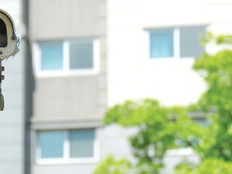Digital Lockdown: How 3 Colleges Enhanced Campus Security
The parking lot was relatively empty and quiet at Ivy Tech Community College in Bloomington, Ind., in the weeks before classes started this year, so a perpetrator thought he could easily get away with stealing a notebook computer left in a parked car.
Fortunately, Ivy Tech security officials, working with the IT department, had just installed a new surveillance system: 190 Axis Communications digital cameras and ipConfigure video surveillance management and recording software. The system included a digital, remote-zoom camera strategically located to pick up activity in the parking lot in question. The theft, from start to finish and in high-definition color, was recorded, transmitted over the wired campus network and stored to a back-end HP Proliant DL385 G7 server.
When the crime report came in, security officials went straight to the video, says Kyle Giles, director of security at Ivy Tech, and "within an hour, we were able to solve the case and have the police here investigate and make an arrest."
Deterrence Factors
Results like this explain why higher education institutions are investing heavily in state-of-the-art digital camera systems and other IT-enabled security tools, not only to solve crimes but also to deter and prevent them, says Steven Healy, a managing partner for Margolis Healy and Associates, a consulting firm.
"Much of this type of technology really serves as a force multiplier," Healy says, noting that campus security efforts are challenged by scarce resources while facing even more complicated threats. "It basically allows security to have a virtual presence without having to have 100 people patrolling the campus at any given time."
The price tag and difficulty involved in moving to the latest IT-enabled security can vary widely depending on the size of the initial technological gap. For example, until a few years ago, Nicholls State University in Thibodaux, La., relied on manual processes, such as hall monitors and sign-in logs, to keep tabs on activity inside its residence halls.
Craig Jaccuzzo, chief of university police, decided that the time had come for a 21st century model. But the effort to install IT-enabled systems has not been quick or easy. Nicholls succeeded with the upgrade through a measured, creative strategy of adding components at locations with the highest need first.
"We wanted to see if we were really getting the bang for our buck and give our staff a chance to adjust and our IT people time to make sure they could maintain, operate and troubleshoot the systems," Jaccuzzo says.
A Tighter Focus
Ivy Tech, by contrast, had been using an analog-based surveillance camera system for some time to protect its 6,000 students and keep tabs on five campus buildings spread across the city.
But Giles says the analog system wasn't optimal. It failed to provide the ease of use, flexibility and image clarity campus security officials needed to maximize use of recorded video footage. When the school hired Giles in early 2011, he insisted on replacing the existing system with a digital one. The effort required buying a new dedicated server with robust internal storage drives and installing more network switches and alternate network cabling, says Network Administrator Daniel Arvesen. The digital surveillance system went live this past March.
"I wanted a system where the cameras were so good that security staff didn't have to guess what was going on — and we didn't have to wait for it to get dumped to a server or scroll through all the footage to find what we were looking for," Giles says. "With digital, if something happens, I can go right to the camera I want and review the video instantly — and from my iPhone or iPad, if I'm on the road."
Lynchburg College, an independent institution in Lynchburg, Va., also had an existing analog system. The security and IT teams began the transition to a digital system by adding new Axis and Sony pan-zoom IP network cameras at two residence halls that were being renovated. The college now has 145 cameras deployed campuswide, as well as at its Claytor Nature Study Center located 25 miles from the main campus.
A chief benefit is situational awareness, says Bob Driskill, Lynchburg's director of campus safety. "If we get a burglar alarm in a certain building, we can go to that particular camera immediately and see what's going on," he explains. "If there's someone wandering inside a building, we can go to the live video and get a description, know whether that person has a weapon and exactly where he is inside the building. That information will help us make the right call about how to respond as effectively and safely as possible."
But the key to success with any of these types of systems is fostering and valuing a strong relationship between security and IT, he points out. "I always make sure that they understand what we want to do and that they're on board with it because they're the key to making this thing all come together," Driskill says.






